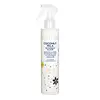What's inside
What's inside
 Key Ingredients
Key Ingredients

No key ingredients
 Benefits
Benefits

 Concerns
Concerns

 Ingredients Side-by-side
Ingredients Side-by-side

Aloe Barbadensis Leaf Juice
Skin ConditioningCetyl Alcohol
EmollientStearyl Alcohol
EmollientBehentrimonium Methosulfate
Cetearyl Alcohol
EmollientBehentrimonium Chloride
PreservativePrunus Armeniaca Kernel Oil
MaskingLens Esculenta Seed Extract
Skin ProtectingHydrolyzed Cicer Seed Extract
Skin ProtectingChenopodium Quinoa Seed Extract
Skin ConditioningStearalkonium Chloride
PreservativeDiheptyl Succinate
EmollientCapryloyl Glycerin/Sebacic Acid Copolymer
Skin ConditioningHydroxyethylcellulose
Emulsion StabilisingCocos Nucifera Oil
MaskingAmaranthus Caudatus Seed Extract
Skin ConditioningHydrogenated Castor Oil/Sebacic Acid Copolymer
EmollientCocos Nucifera Water
MaskingGlycerin
HumectantCocos Nucifera Fruit Juice
EmollientSr-Hydrozoan Polypeptide-1
HumectantCopper Tripeptide-1
Skin ConditioningPanax Ginseng Root Extract
EmollientCaffeine
Skin ConditioningBiotin
AntiseborrhoeicEthylhexylglycerin
Skin ConditioningPhenoxyethanol
PreservativeParfum
MaskingAloe Barbadensis Leaf Juice, Cetyl Alcohol, Stearyl Alcohol, Behentrimonium Methosulfate, Cetearyl Alcohol, Behentrimonium Chloride, Prunus Armeniaca Kernel Oil, Lens Esculenta Seed Extract, Hydrolyzed Cicer Seed Extract, Chenopodium Quinoa Seed Extract, Stearalkonium Chloride, Diheptyl Succinate, Capryloyl Glycerin/Sebacic Acid Copolymer, Hydroxyethylcellulose, Cocos Nucifera Oil, Amaranthus Caudatus Seed Extract, Hydrogenated Castor Oil/Sebacic Acid Copolymer, Cocos Nucifera Water, Glycerin, Cocos Nucifera Fruit Juice, Sr-Hydrozoan Polypeptide-1, Copper Tripeptide-1, Panax Ginseng Root Extract, Caffeine, Biotin, Ethylhexylglycerin, Phenoxyethanol, Parfum
Water
Skin ConditioningGlycerin
HumectantCetyl Alcohol
EmollientParfum
MaskingBehentrimonium Chloride
PreservativeGlyceryl Stearate
EmollientAloe Barbadensis Leaf Juice
Skin ConditioningPanthenol
Skin ConditioningHydrolyzed Soy Protein
HumectantHydrolyzed Barley Protein
Skin ConditioningSimmondsia Chinensis Seed Oil
EmollientCocos Nucifera Water
MaskingButyrospermum Parkii Butter
Skin ConditioningSodium Benzoate
MaskingEthylhexylglycerin
Skin ConditioningIngredients Explained
These ingredients are found in both products.
Ingredients higher up in an ingredient list are typically present in a larger amount.
Aloe Barbadensis Leaf Juice comes from leaves of the aloe plant. Aloe Barbadensis Leaf Juice is best known for helping to soothe sunburns. It is also anti-inflammatory, moisturizing, antiseptic, and can help heal wounds.
Aloe is packed with good stuff including Vitamins A, C, and E. These vitamins are antioxidants, which help fight free-radicals and the damage they may cause. Free-radicals are molecules that may damage your skin cells, such as pollution.
Aloe Barbadensis Leaf Juice also contains sugars. These sugars come in the form of monosaccharides and polysaccharides, folic acid, and choline. These sugars are able to help bind moisture to skin.
It also contains minerals such as calcium, 12 anthraquinones, fatty acids, amino acids, and Vitamin B12.
Learn more about Aloe Barbadensis Leaf JuiceThis ingredient is a preservative and often used for it's anti-static properties. You'll most likely see this ingredient in hair conditioners.
It does not cause irritation or sensitization in leave-on products at 1-5%.
Cetyl Alcohol is a fatty alcohol. Fatty Alcohols are most often used as an emollient or to thicken a product.
Its main roles are:
Though it has "alcohol" in the name, it is not related to denatured alcohol or ethyl alcohol.
The FDA allows products labeled "alcohol-free" to have fatty alcohols.
Learn more about Cetyl AlcoholEthylhexylglycerin (we can't pronounce this either) is commonly used as a preservative and skin softener. It is derived from glyceryl.
You might see Ethylhexylglycerin often paired with other preservatives such as phenoxyethanol. Ethylhexylglycerin has been found to increase the effectiveness of these other preservatives.
Glycerin is already naturally found in your skin. It helps moisturize and protect your skin.
A study from 2016 found glycerin to be more effective as a humectant than AHAs and hyaluronic acid.
As a humectant, it helps the skin stay hydrated by pulling moisture to your skin. The low molecular weight of glycerin allows it to pull moisture into the deeper layers of your skin.
Hydrated skin improves your skin barrier; Your skin barrier helps protect against irritants and bacteria.
Glycerin has also been found to have antimicrobial and antiviral properties. Due to these properties, glycerin is often used in wound and burn treatments.
In cosmetics, glycerin is usually derived from plants such as soybean or palm. However, it can also be sourced from animals, such as tallow or animal fat.
This ingredient is organic, colorless, odorless, and non-toxic.
Glycerin is the name for this ingredient in American English. British English uses Glycerol/Glycerine.
Learn more about GlycerinParfum is a catch-all term for an ingredient or more that is used to give a scent to products.
Also called "fragrance", this ingredient can be a blend of hundreds of chemicals or plant oils. This means every product with "fragrance" or "parfum" in the ingredients list is a different mixture.
For instance, Habanolide is a proprietary trade name for a specific aroma chemical. When used as a fragrance ingredient in cosmetics, most aroma chemicals fall under the broad labeling category of “FRAGRANCE” or “PARFUM” according to EU and US regulations.
The term 'parfum' or 'fragrance' is not regulated in many countries. In many cases, it is up to the brand to define this term.
For instance, many brands choose to label themselves as "fragrance-free" because they are not using synthetic fragrances. However, their products may still contain ingredients such as essential oils that are considered a fragrance by INCI standards.
One example is Calendula flower extract. Calendula is an essential oil that still imparts a scent or 'fragrance'.
Depending on the blend, the ingredients in the mixture can cause allergies and sensitivities on the skin. Some ingredients that are known EU allergens include linalool and citronellol.
Parfum can also be used to mask or cover an unpleasant scent.
The bottom line is: not all fragrances/parfum/ingredients are created equally. If you are worried about fragrances, we recommend taking a closer look at an ingredient. And of course, we always recommend speaking with a professional.
Learn more about Parfum